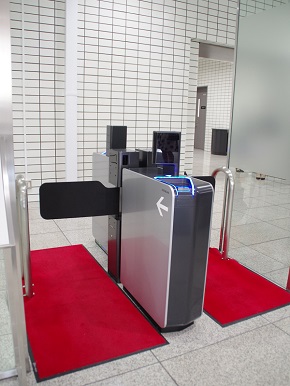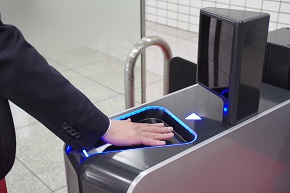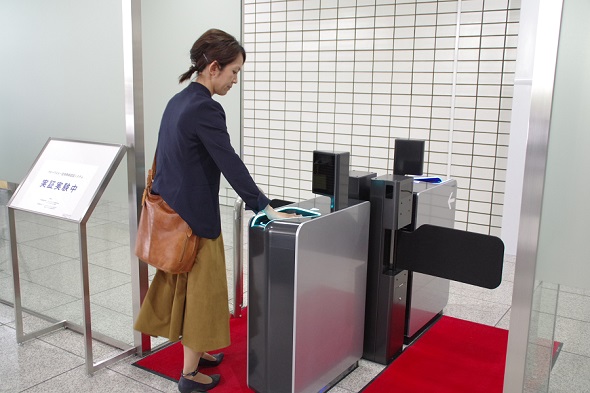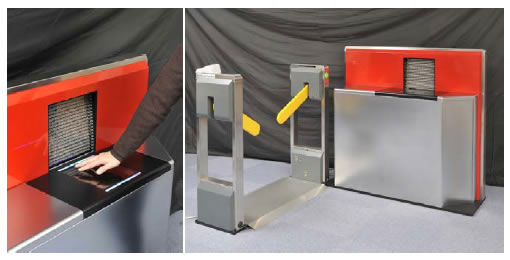https://www.itmedia.co.jp/enterprise/articles/1704/27/news042.html
シェアしました。
日立が東京・大森にあるオフィスに、指静脈による認証で入退館を管理するゲートを設置。歩きながら指をかざすだけで正確な本人確認をする実証実験を行っている。鉄道の改札機と同等の応答速度を目指すとのことだが、本当に可能なのだろうか?
2017年04月27日 08時00分 公開
[森実南,ITmedia]
「ボーっとしていて、改札機で社員証をかざしてしまった……」
皆さんの中に、そんな恥ずかしい経験をしたことがある人はいないだろうか。
非接触型ICカードが登場してから、駅の改札機やビルの入退館ゲート、執務室の出入口などに、私たちは1日に何度もカードをかざすようになった。急いでいたり、慌てていたりすると、カードを間違えることもあるし、何よりカードをバッグから取り出すのが面倒だ。
しかし、これからはカードではなく「手」をかざしてゲートを通り抜ける――そんな行為が当たり前になるかもしれない。日立製作所(日立)が今、東京・大森にあるオフィスで、指静脈による認証で入退館ができるゲートを設置し、社員700人ほどで実証実験を行っているという。改札機と同等の応答速度を目指すとのことだが、実際のところはどうなのか。大森に向かい、実機が動いている様子を見てきた。
手をかざせば、0.3秒で認証が終わる世界
日立が実証実験を行っているのは「ウォークスルー型指静脈認証」の技術。なりすましのリスクが低い「指静脈」を使い、センサー部に手をかざすことで、立ち止まることなく認証を行えるのが特徴だ。従来の指静脈認証は、決められた位置に指を置くために立ち止まる必要があったが、最新の技術では、指の検出範囲を広げ、かざした指の数や位置、向きが変化しても、瞬時に指静脈パターンを検知できるようにしている。
実際に人がゲートを通過する様子を見ると、手をかざすとすぐに認証が行われており、認証で待たされて渋滞が起きるようなことはなかった。改札機のICカードをかざす部分に相当する、手前のLEDが点灯しているエリアに手をかざす構造になっており、利用者にとっては慣れた動きになる。照合処理を高速化することで、「指をかざしてから認証までが約0.3秒で終わる」(日立)とのことだが、実際にその程度で認証ができていた印象だ。
実験が3月下旬に始まって約1カ月が経過した今、約700人が指静脈を登録し、日常的に指静脈認証ゲートを利用しているという。利用者の満足度は高く、今のところ誤認証は起きていないそうだ。
日立のウォークスルー型指静脈認証ゲート。駅の改札機のようなスピードで認証が行えているのが分かる
実はこのウォークスルー型指静脈認証は、2014年12月に既に発表されていた技術だ。この実証実験が始まるまでに2年以上かかったことになるが、その裏では一体何が起きていたのだろうか。
ウォークスルー型指静脈認証の問題点
日立が指静脈認証技術の開発を始めたのは1997年で、技術自体には20年の歴史がある。これまでドアや銀行のATM、PCなどに内蔵する製品を展開してきたが、その応用領域を通用ゲートなどのフィジカルセキュリティ方面に拡大し、ウォークスルー型指静脈認証を発表した。
発表したコンセプトモデルでは、かざした指の位置と向きに合わせ、指先を狙って近赤外線を照射し、血中のヘモグロビンが近赤外線を吸収する特性を利用して、指の静脈パターンを撮影していた。複数の指静脈パターンを照合に用いることで、高い精度も担保できたという。
しかし、このシステムには大きな課題が2つあった。まずは認証精度の問題だ。高い認証精度を誇るものの、それは各指をある程度開いた状態での話。指を閉じてしまうと、指の境目が認識できず、静脈パターンを検知するのが困難だった。さらに手をセンサーに接触させずに認識する場合、周りから光が入りこんでしまい、環境によっては静脈パターンが分かりにくかった。
もう1つは照合処理の速度だ。コンセプトモデルでは、1分あたり70人をさばける速度だったが、これは認証用に登録しているデータが「100人弱くらいだった」(日立)ため。登録する人数が増えれば、それだけ照合にかかる時間も増えてしまう。ビルや空港内といった大規模利用を考えると、登録人数の増加に耐え得るシステムが必要だった。
新生「ウォークスルー型指静脈認証」は何が違う?
まず、“指閉じ問題”については、可視光と赤外線の両方で手の形を検知することで、指1本1本の形状把握に成功。非接触時の検知については、静脈パターンのコントラストを優先する形で近赤外線の強弱を調整することで、画像の精度が高まった。
照合処理については、画質が粗い縮小画像で照合を行い、候補を10分の1程度に絞り込んだあとに、再び通常の画質で照合を行う「二段階照合」方式を採用したほか、複数本の指をまとめて照合する際のパターンを最適化することで、理論値ベースで当初の約41倍という高速化を実現した。
「1000人分のデータが登録された状態でも、2014年のモデルと変わらぬ応答速度を保っています。今後、CPUやカメラの性能が上がったり、AIやディープラーニングを活用したりすることで、さらなる高速化も見込めます」(日立製作所 システムイノベーションセンタ 主管研究員 長坂晃朗氏)
このほか、非接触操作に適したデザイン変更や、システム全体の小型化といった改善も加え、これらの課題を解決するのに2年弱を要したという。
「指静脈認証」の強みと弱点
静脈認証は赤外線を利用するため、顔や虹彩といった他の生体認証に比べて、環境光による影響を受けにくい。そのため、屋内だけでなく、屋外での利用にも向くメリットがある。日立製作所 セキュリティイノベーション推進センタ センタ長の澤田昭人氏によると、指静脈認証はプライバシーと使いやすさにも強みがあるという。
「顔などをカメラで撮影されるよりも、指を撮影される方が、プライバシーの側面で利用者の抵抗は少ないと感じています。そして今回のような実装なら、Suicaなどの非接触型ICカードをかざす感覚で使えるため、普及への心理的ハードルも少ないでしょう」(澤田氏)
一方で普及のネックになるポイントもある。あらかじめ静脈パターンのデータを登録しなければならない点だ。認証時に近赤外線を使うため、登録にも専用の装置を使う必要があり、登録のためのハードルが高い。空港やスタジアムなど、1万人や10万人規模で使うケースでは、これが大きな問題となり得る。
「登録自体は20秒程度で終わるのですが、専用機器が必要なところなど、運用面での課題は残ります。日立では、スマートフォンで指静脈を認証する技術も開発しており、将来的にはこうした技術と連携したり、他企業や行政と協力したりすることで解決できればと思っています」(長坂氏)
Suicaの代わりに「手」をかざす日がやってくる?
この実証実験は2017年12月末まで行う予定で、今後は実運用における課題抽出や技術改善を経て、製品化や10万人規模の利用を目指して研究を続けていくという。製品化の際は「海外での展開も想定しており、ハードウェアを売るよりもサービスとして販売するイメージ」(澤田氏)とのことだ。
2020年に東京オリンピックが控えていることもあり、サイバーセキュリティに加えて、現実世界におけるセキュリティへの注目や需要は高まりつつある。静脈認証についても、決済システムとの連携を模索する実証実験が行われるなど、さまざまなビジネスへ応用できる可能性が広がってきている。
海外では、カメラやセンサーを活用してレジなしスーパーを実現している「Amazon Go」といった新形態の店舗が出てきているが、Suicaの代わりに「手」をかざして、改札やレジを止まらずに抜けていく――日本でもそういうことができるようになる日は、そう遠くないのかもしれない。
Copyright © ITmedia, Inc. All Rights Reserved.
Will the era of holding hands instead of Suica come? I've been looking at Hitachi's walk-through type finger vein authentication.
https://www.itmedia.co.jp/enterprise/articles/1704/27/news042.html We
shared.
 A gate has been set up at Hitachi's office in Omori, Tokyo, which allows you to enter and exit with finger vein authentication.
A gate has been set up at Hitachi's office in Omori, Tokyo, which allows you to enter and exit with finger vein authentication.
 It is also a big point that the device is downsized and the design is changed. Regarding the design side, it is said that it makes it easier to understand the height of holding your hand by making a depression
It is also a big point that the device is downsized and the design is changed. Regarding the design side, it is said that it makes it easier to understand the height of holding your hand by making a depression
shared.
Hitachi has installed a gate in its office in Omori, Tokyo, which manages entrance and exit with finger vein authentication. We are conducting a verification test to confirm the identity accurately by simply holding up a finger while walking. You say that you aim to have a response speed that is equivalent to that of a ticket gate of a railway, but is it really possible?
Apr 27, 2017 08:00:00
[ Minami Minami , ITmedia]
 A gate has been set up at Hitachi's office in Omori, Tokyo, which allows you to enter and exit with finger vein authentication.
A gate has been set up at Hitachi's office in Omori, Tokyo, which allows you to enter and exit with finger vein authentication.
"I was in a hurry, and I held my employee ID over the ticket gate..."
I wonder if any of you have had such an embarrassing experience.
Since the advent of contactless IC cards, we have come to hold the cards over and over at the ticket gates at stations, the entrance and exit gates of buildings, and the entrances and exits of offices. If you are in a hurry or in a hurry, you may make a mistake in the card, and above all, it is troublesome to take out the card from the bag.
However, from now on, you can pass through the gate by holding your "hand" instead of the card-that kind of behavior may become the norm. Hitachi, Ltd. (Hitachi) is now in an office in Tokyo, Omori, has installed a gate that can be entered and exited by authentication with a finger vein, and about 700 employees are conducting demonstration tests. You say that you aim for a response speed equivalent to that of a ticket gate, but what is the actual situation? I went to Omori and saw the actual machine in action.
A world where authentication is completed in 0.3 seconds if you hold your hand
Hitachi is conducting demonstration experiments with the "walk-through finger vein authentication" technology. The feature is that you can authenticate without stopping by using a "finger vein" with a low risk of spoofing and holding your hand over the sensor. In conventional finger vein authentication, it was necessary to stop to place a finger at a predetermined position, but with the latest technology, the detection range of the finger is expanded and even if the number, position, or direction of the held fingers changes. The finger vein pattern can be instantly detected.
When I saw how people actually passed through the gate, they were authenticated as soon as they held their hands up, and there was no need to wait for the authentication to cause traffic congestion. The structure is such that you can hold your hand over the area in front of which the LED is lit, which is equivalent to holding the IC card of the ticket gate. By speeding up the matching process, "it takes about 0.3 seconds from the time you hold your finger up to the verification" (Hitachi), but the impression is that the verification was actually completed.
About a month has passed since the experiment started in late March, and about 700 people have registered their finger veins and are using the finger vein authentication gate on a daily basis. User satisfaction is high, and there is no false authentication so far.
Hitachi walk-through type finger vein authentication gate. You can see that the authentication is done at the speed of a ticket gate at a station.
In fact, this walk-through type finger vein authentication is a technology that was already announced in December 2014 . It took more than two years before this demonstration experiment began, but what was the mere reason behind it?
Problems of walk-through type finger vein authentication
Hitachi started developing finger vein authentication technology in 1997, and the technology itself has a 20-year history. So far, we have developed products built into doors, ATMs of banks, PCs, etc., but expanded the application area to physical security areas such as universal gates and announced walk-through type finger vein authentication.
In the announced concept model, the vein pattern of the finger is photographed using the characteristic that hemoglobin in the blood absorbs the near-infrared rays by aligning the position and orientation of the finger held up and aiming at the fingertip and irradiating the near-infrared ray. It was By using multiple finger vein patterns for matching, high accuracy was also guaranteed.
However, there were two major problems with this system. First is the problem of authentication accuracy. Although it boasts high authentication accuracy, it is a story with each finger open to some extent. When the finger was closed, the boundary between the fingers could not be recognized and it was difficult to detect the vein pattern. Furthermore, when recognizing without touching the sensor with hands, light entered from the surroundings, making it difficult to understand the vein pattern in some environments.
The other is the speed of the matching process. In the concept model, the speed was 70 people per minute, but this is because the data registered for authentication was "about 100 people" (Hitachi). The more people you register, the more time it will take to collate. Considering large-scale use in buildings and airports, a system that can withstand an increase in the number of registered people was necessary.
What is different about the new "walk-through type finger vein authentication"?
First, regarding the “finger closing problem”, we succeeded in grasping the shape of each finger by detecting the shape of the hand with both visible light and infrared light. For non-contact detection, the accuracy of the image was improved by adjusting the intensity of near-infrared rays while giving priority to the contrast of the vein pattern.
Regarding the matching process, the “two-step matching” method is adopted in which matching is performed with reduced images with coarse image quality, candidates are narrowed down to about 1/10, and then matching is performed with normal image quality again. By optimizing the pattern for collating all fingers together, we achieved a speedup of about 41 times the initial value based on the theoretical value.
"Even with the data for 1000 people registered, we are maintaining the same response speed as the 2014 model. In the future, by improving the performance of the CPU and camera, and utilizing AI and deep learning, We can expect higher speeds" (Akira Nagasaka, Senior Researcher, System Innovation Center, Hitachi, Ltd.)
In addition, it took less than two years to solve these problems by making design changes suitable for non-contact operation and improving the system as a whole.
Strengths and weaknesses of "finger vein authentication"
 It is also a big point that the device is downsized and the design is changed. Regarding the design side, it is said that it makes it easier to understand the height of holding your hand by making a depression
It is also a big point that the device is downsized and the design is changed. Regarding the design side, it is said that it makes it easier to understand the height of holding your hand by making a depression
Since vein authentication uses infrared rays, it is less affected by ambient light than other biometric authentication such as faces and irises. Therefore, there is a merit that it is suitable not only for indoor use but also for outdoor use. According to Akito Sawada, the director of the Security Innovation Promotion Center of Hitachi, Ltd., finger vein authentication has strengths in privacy and ease of use.
“I feel that there is less user resistance in terms of privacy when shooting a finger than when shooting a face with a camera. With this implementation, a non-contact IC such as Suica Since it can be used as if holding a card, there are few psychological hurdles to popularization.” (Mr. Sawada)
On the other hand, there are also points that will become a bottleneck for diffusion. The point is that vein pattern data must be registered in advance. Since near infrared rays are used at the time of authentication, it is necessary to use a dedicated device for registration, and the hurdle for registration is high. This can be a big problem in the case where it is used by 10,000 or 100,000 people such as an airport or a stadium.
"Registration itself takes about 20 seconds, but there are still operational issues such as the need for a dedicated device. Hitachi is also developing technology to authenticate finger veins with smartphones, and in the future Would like to be able to solve this problem by collaborating with such technologies and with other companies and governments." (Mr. Nagasaka)
Will the day come when you hold your hand instead of Suica?
This demonstration test is scheduled to be conducted until the end of December 2017, and in the future it will continue research aiming to commercialize and use it for 100,000 people after identifying issues and technical improvements in actual operation. At the time of commercialization, he said, "We are thinking of expanding overseas, and we sell it as a service rather than selling hardware" (Sawada).
With the Tokyo Olympics ahead of 2020, attention and demand for real-world security in addition to cybersecurity are increasing. With regard to vein authentication, the possibility of applying it to various businesses is expanding, as proof experiments are being conducted in search of cooperation with payment systems.
Overseas, new types of stores such as ``Amazon Go,'' which uses cameras and sensors to realize supermarkets without cash registers, are appearing, but instead of Suica, hold your hand and stop the ticket gates and cash registers. Without leaving--it may not be long before Japan will be able to do that.
Copyright © ITmedia, Inc. All Rights Reserved.

 2014年に発表したウォークスルー型指静脈認証ゲート(出典:日立製作所)
2014年に発表したウォークスルー型指静脈認証ゲート(出典:日立製作所) 日立製作所 システムイノベーションセンタ 主管研究員 博士(工学) 長坂晃朗氏
日立製作所 システムイノベーションセンタ 主管研究員 博士(工学) 長坂晃朗氏 日立製作所 セキュリティイノベーション推進センタ センタ長の澤田昭人氏
日立製作所 セキュリティイノベーション推進センタ センタ長の澤田昭人氏







0 コメント:
コメントを投稿